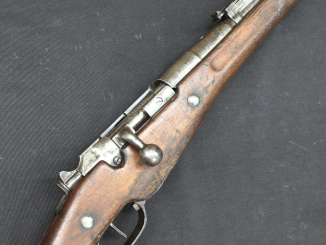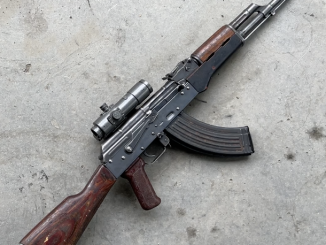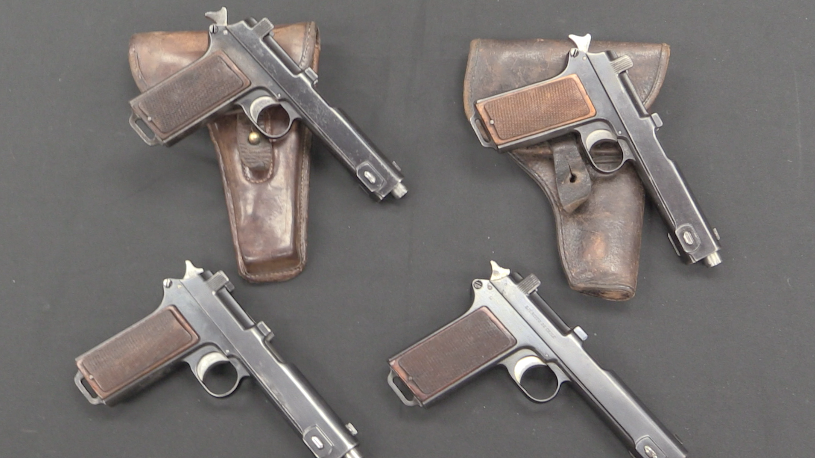Towards the end of the Cold War, Romania was a major exporter of arms and ammunition on the world market. Today we are looking at Romanian pattern 1971 8mm Mauser ammunition, made between 1972 and 1978 (this particular sample is form 1972). It was produced at the U.M. Sadu plant in Bumbesti Jiu, Romania. At the time of production, Romania had no 8mm Mauser firearms in active military service, suggesting that this ammunition was made for export (or perhaps a planned weapon which never actually saw adoption). Interestingly, the cases across the entire production run of this ammo are about 1mm shorter than standard 8mm Mauser, measuring closer to 56mm than 57mm. The shoulder is in the proper location, and this slightly short neck does not appear to produce any abnormal effects, either positive or negative.
The ammunition is packed in wooden crates, each containing two sealed tins. It was packaged both loose in boxes (20 rounds per box, 380 rounds per tin, 760 rounds per crate) and also on 5-round Mauser stripper clips (15 rounds per box, 340 rounds per tin, 680 rounds per crate). This particular sample is packaged loose.
Velocity:
I tested velocity using an 8mm Kar98k Mauser rifle (barrel length 23.6 inches). Measurements were taken at 10 feet from the muzzle, with a sample size of 15 rounds fired. I found an average velocity of 2674 fps, extreme spread of 107 fps (max 2716, min 2609), and standard deviation of 25.75 fps. None of the rounds exhibited any unusual behavior when fired. In my experience outside this specific test, this ammunition has never shown and duds or hangfires.
Bullets:
I tested the weight of 10 bullets using a calibrated Lyman electronic scale. I found an average weight of 154.2 grains, extreme spread of 2.4 grains (max 155.4 gr, min 153.0 gr), and standard deviation of 0.86 grains. Bullet construction is boattail base with an open base, and the bullet attract a magnet.
The primers are Berdan and corrosive. The cases are lacquered steel.
Raw data:
Velocities (fps): 2671, 2664, 2677, 2654, 2609, 2695, 2698, 2668, 2688, 2678, 2639, 2688, 2716, 2701, 2669
Bullet weights (grains): 153.8, 155.4, 154.8, 153.3, 154.0, 155.0, 153.0, 153.1, 155.3, 154.1




“Towards the end of the Cold War, Romania was a major exporter of arms and ammunition on the world market.”
See this interesting Libyan Conflict Oddity:
https://rogueadventurer.com/2012/01/05/a-libyan-conflict-oddity-romanian-model-80-30mm-aa-gun/
Communist tetanus lol.
I was in Romania in 1992, I was hanging out in Brasov with some people who had witnessed the “revolution” and one had recovered one of those 8mm cartridges from the street after the battle and showed it to me. I always wondered what it was doing there. Perhaps there were Kar98’s left for some kind of reservists?
Duchamp:
There may be something to that. Communist states always seemed to like holding on to all captured firearms, and Romania must have had a lot of Kar98k’s and MG34s left behind after the war, which would have been useful for factory militias and all those other armed units Communists are so fond of. It would have made perfect sense to manufacture 7.92mm for these captured weapons.
Would it be possible, sometime down the road, to put together some sort of summary/recap of all the types of surplus ammo of a given caliber? Sort of “I’ve tested these six versions of 8mm Mauser; X was the most consistent, Y was the most reliable, etc etc” and maybe a recommendation or a pro/con of the various offerings
“nice hiss” hahaha, thanks, steve!
The Patriotic Guard (Gărzile Patriotice) used some Vz24 rifles and Zb26s in addition to some Mg34s and Mg42s. So it more than likely was produced for them and stockpiled in case of an emergency (such as an invasion) and also sold abroad.
Among cartrdge collectors the opinion is that this ammunition was indeed produced for German 7.9 mm rifles and machine guns (MG34) still held as reserve stock at the time. Because of the destination for old weapons, the load is considerably below the standard data.
When it was sold in Germany, I had 15 rounds (Factory 22, year 72 like yours) tested in a CIP pressure barrel. The velocity was significantly lower than your results (790 m/s, 2590 fps). The average pressure was a little under 2700 bar (70 percent of the 3900 bar CIP maximum for this cartridge).
But even your 815 m/s are considerably below what would be expected from the original S cartridge. We have a very moderate load here.
Like you I was pleasantly surprised by the small variation in bullet weight, its iron core notwithstanding. On the other hand, the cases have a very tight grip on the bullets. Using a kinetic bullet puller is really hard work with these cartridges.
This looks like decent ammo in terms of performance. If the average pressure is at around 39,000 PSI as previous writer reports, it is still more than common “lighter” round introduced in early 1930s which was loaded to 35,000 PSI. This also happen to be SAAMI recommended pressure, well under its actual capacity, but not a slouch by any means.
https://en.wikipedia.org/wiki/7.92%C3%9757mm_Mauser
As this cartridge was used by many countries through many years multiple variants of loading existed, also even if limit only to Germany, interestingly according to http://www.oocities.org/augusta/8172/panzerfaust5.htm
in Czechoslovakia ZB 1930 J was produced, which was derivative of ZB 1930 which was more tolerant to accept a wider range of ammunitions of differing manufacturing quality
I recall short exchange with one of older instructors in my weapon-tech course during my service. Based on reading, I was that time (1968) full of enthusiasm for brand new M16. He listened a bit, then chuckled and asked me: “and what do you want to shoot with it, rabbits?”.
Of course, he was brought up on old trusty 8x57mm and that’s what all he knew. He did not care about any ‘rabbit gun’ inventions. Mauser 8mm was probably the best overall cartridge just prior to assault rifles time period.
“Mauser 8mm was probably the best overall cartridge just prior to assault rifles time period.”
I would say that ~8 mm rifle-machine gun cartridge of that period, were all quite similar (in terms of momentum) when measured near muzzle, with differences increasing with range, depending on how well bullet was designed.
For comparison
7,9 x 57 mm with S bullet: 10,0+0,1 g bullet at 890 m/s
303 British Mark VII: 11,3 g bullet at 745 m/s (Lee-Enfield)
8 mm Lebel (French) with D bullet: 12,8 g bullet at 700 m/s (Lebel)
7,62 mm Mosin with light (pattern 1908/30) bullet: 9,5…9,7 g bullet at 860…875 m/s.
Respective momentum is: 8900, 8418.5, 8960, 8170…8487.5 – general similarity might be explain by fact they wanted maximal what average soldier could bear in term of recoil (fatigue from recoil) as these were cartridge which were supposed to be used both in rifles and machine guns.
7,9×57 mm Mauser certainly has advantage of being rimless design.
One good thing which plays for 8mm Mauser is relatively slim case at the base. That allows for less material bulk in chamber area. That also translates to easier feeding due to lesser vertical transfer.
Can this cartridge be used in a Turked G88 with original barrel? It is an “S” conversion. Thanks.
Since this round is a lighter load than most milsurp?